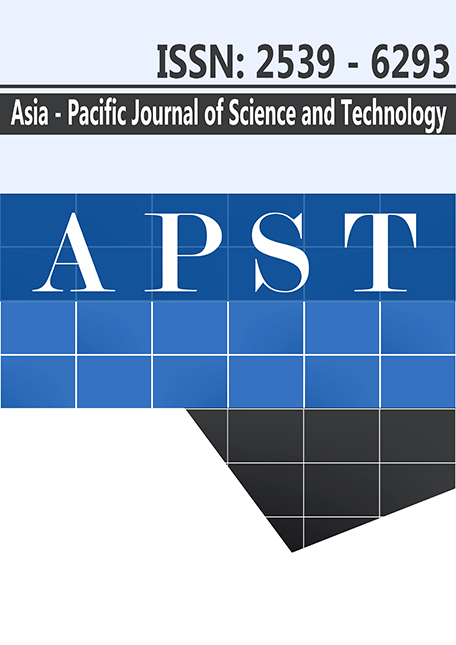Factors affecting electricity consumption of hotel buildings in Thailand
Main Article Content
Abstract
This paper presents a study on energy performance of Thailand’s hotel buildings. Energy consumption data, hotel characteristics and operational data were collected from 63 hotels through a technical survey. The annual Electricity Consumption Intensities (ECI) of the sampled hotels were then calculated and the parameters affecting electricity consumption of the hotels were analyzed using Pearson correlation. Results indicated that most of the sampled hotels in Thailand consumed electricity, liquefied petroleum gas (LPG) and diesel fuel. Electricity was the primary energy source, accounting for 69% to 94% of the consumption in various hotels. Electricity was mainly used in air conditioning (57%), followed by lighting (18%), escalators (9%), water heating (8%), and fans and pumps (8%). The average annual ECIs of hotel buildings in Thailand were 321.84 kWh/m2, 35,210.40 kWh/guest room and 2,292.36 kWh/room night. Pearson correlations showed that worker density had a positive correlation with the monthly ECI in kWh/m2 with a 99% confidence level, whereas Occupancy Rates (OR) had a negative correlation with the monthly ECI in kWh/room night at a 95% confidence level. A predictive model was determined based on a stepwise linear regression. It indicated that the optimization of some hotel operational factors, such as the number of room nights, number of workers, worker density and OR could lead to significant decreases in electricity consumption in Thai hotel buildings.
Article Details
References
302.
[2] U.S. Energy information administration., 1998. Energy Consumption and Energy Expenditures. Washington
DC.
[3] Deng, S., Burnet,t J., 2002. Energy use and management in hotels in Hong Kong. International Journal of
Hospitality Management 21, 371-380.
[4] Rajagopalan, P., Xuchao, W., Eang, L.S., 2009. A study on energy performance of hotel buildings in
Singapore. Energy and Buildings 41, 1319-1324.
[5] Xuchao, W., Rajagopalan, P., Eang, L.S., 2010. Benchmarking energy use and greenhouse gas emission in
Singapore’s hotel industry. Energy Policy 38, 4520-4527.
[6] Huang, Y.C., Yang, S., Luo, C.H., 2010. Evaluation and willingness to pay of greenhouse gas emissions for
leisure buildings: a case hotel. In: Institute for Environment, Engineering, Economics and Applied
Mathematics, Proceedings of the 2010 International Conference on Urban Sustainability, Cultural
Sustainability, Green Development Green Structures and Clean Cars; 2010; Malta, 109-111.
[7] Commonwealth of Australia., 2002. Energy efficiency opportunities in the hotel industry sector. Canberra:
Legislative Services.
[8] Asia-Pacific Economic Cooperation (APEC)., 2010. Peer Review on Energy Efficiency in Thailand, Report
for the APEC Energy Working Group [WWW Document] URL
https://aperc.ieej.or.jp/file/2010/9/26/PREE20100414_Thailand.pdf. (accessed 12. 01. 12).
[9] Technology Promotion Association (Thailand-Japan)., Hotels and resorts: Industry analysis [WWW
Document]. URL https://www.sme.go.th/Pages/home.aspx# Thai. (accessed 12. 04. 13).
[10] Department of Thailand Tourism, Ministry of Tourism and Sports, Thailand., Tourist Arrivals in Thailand
[WWW Document]. URL https://service.nso.go.th/nso/nso_center/project/search_center/23projectth.htm.(accessed
12. 01. 12). (Thai).
[11] Tourism Authority of Thailand, Ministry of Tourism and Sports, Thailand. Number of Hotel and room by
type of Accommodation: 2002 – 2006. [WWW Document]. URL
https://service.nso.go.th/nso/nso_center/project/search_center/23project-th.htm .(accessed 12. 01. 12). (Thai).
[12] Office of the National Economic and Social Development Board. The Eleventh National Economic and
Social Development Plan (2012-2016). [WWW Document]. URL
https://www.nesdb.go.th/Portals/0/news/plan/p11/Plan11_eng.pdf. (accessed 12. 01. 12). (Thai).
[13] The Department of Alternative Energy Development and Efficiency, Ministry of Energy, Thailand.
Manual Explanation of Energy Conservation Act B.E. 2535 (Amended) For Designated Factory / Designated
Building [WWW Document]. URL https://www2.dede.go.th. (accessed 10. 06. 14).
[14] Xydis, G., Koroneos, C., Polyzakis, A., 2009. Energy and exergy analysis of the Greek hotel sector: An
application. Energy and Buildings 41, 402-406.
[15] Alamoudi, R., 2009. Resource Use, Waste, and Total Productivity Management in Saudi Arabia Hotel
Industry. International Journal of Basic and Applied Science 9, 43-54.
[16] Mohee, R., Bhurtun, C., Energy use in hotel in small island tropical states. [WWW Document] URL
Available from: https://active.cput.ac.za/energy/past_papers/ICUE/2007/PDF/C_Bhurtun.pdf. (accessed 11.
12. 13).
[17] Becken, S., 2000. Energy use in New Zealand Accommodation Sector-Report of a survey, Landcare
Research and Tourism. New Zealand: Research and Education Centre (TREC).
[18] Adelphi consult., 2009. Carbon Footprint Tourism Industry; Koh Chang Cluster: Documentation of the
Baseline. Bangkok: Bangkok Office and Designated Areas for Sustainable Tourism Administration
(DASTA).
[19] Bohdanowicz, P., Martinac, I., 2007. Determinants and Benchmarking of Resource Consumption in HotelsCase
Study of Hilton International and Scandic in Europe. Energy and Buildings 39, 82-95.
[20] The Energy conservation Center., Energy conservation for hotel. [WWW Document]. URL
https://www.asiaeec-col.eccj.or.jp/brochure/pdf/hotels.pdf. (accessed 12. 01. 12).
[21] Treerattanapan, J., 2011. Analysis of Energy Consumption in a Small-size Hotel [M.Phil thesis]. School of
Energy, Environment and Material: King Mongkut’s University of Technology Thonburi. (Thai).
[22] Kammerud, R.C., Blanc, S.L., Kane, W.F., 2012. The Impact of Real-Time Pricing of Electricity on Energy
Use. Energy Cost, and Operation of a Major Hotel. 4.201-4.210.
[23] Papamarcou, M., Kalogirou, S., 2001 Financial appraisal of a combined heat and power system for a hotel
in Cyprus. Energy Conversion and Management. 42, 689-708.
[24] Green leaf foundation., Green leaf hotel standard. [WWW Document]. URL https://greenleafthai.org/en/green_standard/hotel/index.php. (accessed 13. 12. 13). (Thai).
[25] Climatological Center., Thai Meteorological Department. Annual Weather Summary of Thailand in 2011
[WWW Document]. URL https://www.tmd.go.th/programs%5Cuploads%5CyearlySummary%5CAnnual2011_up.pdf. (accessed 10. 06. 14).
[26] Strahler, A.N., 1984. and Strahler AH. Bibliography in Elements of Physical Geography. John Wiley & Sons.
[27] Pidwirny, M., 2006. Climate Classification and Climatic Regions of the World in Fundamentals of Physical Geography; 2nd.

